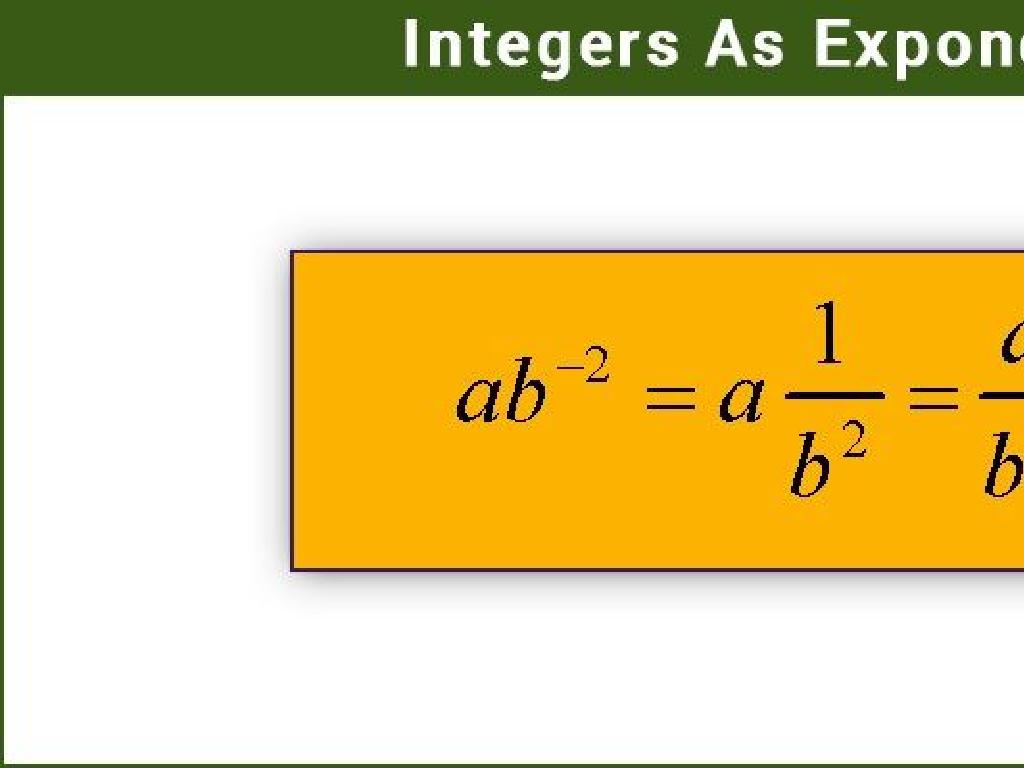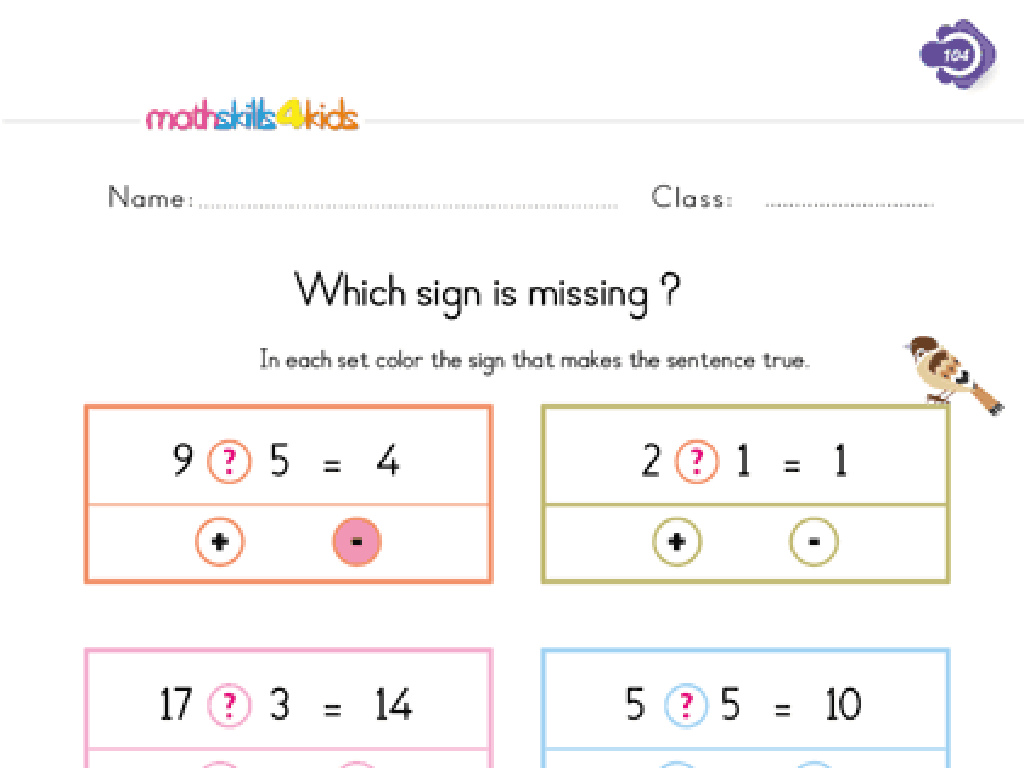Fractions Of A Whole: Word Problems
Subject: Math
Grade: Fourth grade
Topic: Equivalent Fractions
Please LOG IN to download the presentation. Access is available to registered users only.
View More Content
Welcome to Fractions: Solving Word Problems
– Understanding parts of a whole
– A fraction represents a part of a whole object or a set of objects.
– Focus: Fractions in word problems
– Read problems to find fractions describing parts of a whole.
– Learn to identify equivalent fractions
– Equivalent fractions are different fractions that represent the same value.
– Solve problems with equivalent fractions
– Use multiplication or division to find equivalent fractions and solve.
|
This slide introduces students to the concept of fractions as parts of a whole and sets the stage for applying this understanding to word problems. The learning goal is to identify and solve problems involving equivalent fractions. Start by explaining what a fraction is and how it can represent parts of a single object or a group. Then, guide students through the process of reading word problems to find and interpret fractional information. Emphasize the concept of equivalent fractions by showing how different fractions can express the same amount. Provide examples and practice problems where students use multiplication or division to find equivalent fractions that help solve the word problems. Encourage students to visualize the problems with drawings or manipulatives to aid their understanding.
Understanding Fractions
– A fraction shows part of a whole
– Like a piece of a pie or a slice of pizza
– Numerator and denominator explained
– Top number (numerator) is the part we have, bottom number (denominator) is the total parts
– Example: 1/2 of a pizza
– If a pizza is cut into 2 slices and you have 1, that’s 1/2 of the pizza
|
This slide introduces the concept of fractions to fourth-grade students. Begin by explaining that a fraction represents a part of a whole item or group. Use tangible examples like pieces of pie or slices of pizza to illustrate the concept. Clarify that the numerator, the top number of a fraction, indicates how many parts we have, while the denominator, the bottom number, shows the total number of equal parts the whole is divided into. For instance, if a pizza is cut into two equal slices and you take one, you have one out of the two slices, which is represented as 1/2. Encourage students to think of other examples of fractions they encounter in everyday life.
Understanding Equivalent Fractions
– Equivalent fractions basics
– Fractions equal in value, but look different
– Examples of equivalent fractions
– 1/2 equals 2/4 or 3/6
– Finding equivalent fractions
– Multiply or divide top and bottom by the same number
|
This slide introduces the concept of equivalent fractions, which are different fractions that represent the same part of a whole. Start by explaining that even though these fractions may look different, they are just different ways of expressing the same value. Use visual aids like pie charts or fraction bars to show how 1/2, 2/4, and 3/6 cover the same amount of space. Teach students the method of finding equivalent fractions by multiplying or dividing both the numerator (top number) and the denominator (bottom number) by the same non-zero number. Provide practice problems where students can apply this method to find equivalent fractions for given examples.
Word Problems with Fractions
– Applying fractions to life
– Key steps to solve problems
– Read the problem, identify fractions involved, and look for equivalents to solve
– Example: Pizza slices
– If 4/8 of a pizza is eaten, what fraction is left?
– Finding equivalent fractions
– Use multiplication or division to find fractions equal in value
|
This slide introduces students to the concept of using fractions in word problems, which helps them understand fractions in a practical context. Emphasize the importance of reading the problem carefully to identify the fractions involved. Then, guide them through the process of finding equivalent fractions to solve the problem. Use an example like pizza slices to make it relatable and easier to visualize. Explain that equivalent fractions are different fractions that represent the same part of a whole, and show how to find them by multiplying or dividing the numerator and denominator by the same number. Encourage students to practice with different word problems to become comfortable with the concept.
Understanding Fractions with Word Problems
– Sam ate 2/4 of a pizza
– His friend ate the same amount
– Each ate 1/2 of the pizza
– 2/4 is equivalent to 1/2
– Together, they ate a whole pizza
– Adding the fractions: 1/2 + 1/2 = 1
|
This slide presents a word problem to help students understand equivalent fractions and addition of fractions. Start by reading the problem aloud and let students visualize Sam eating 2/4 of a pizza. Clarify that ‘equivalent’ means ‘the same amount’ and show that 2/4 can be simplified to 1/2. Then, demonstrate how to add the two halves together to make a whole. Use visual aids like pizza drawings if possible. Encourage students to think of other examples where they might split something into halves and then combine them. This exercise will reinforce the concept of equivalent fractions and addition of fractions in a relatable context.
Practice Time: Solving Fraction Word Problems
– Try a word problem on your own
– Look for clues to find equivalent fractions
– Clues like ‘half as much’ or ‘twice’ can hint at equivalents
– Solve the problem with a partner
– Two heads are better than one, share ideas!
– Discuss your solution and reasoning
– Explaining your thinking helps you learn
|
This slide is designed to engage students in active problem-solving with their peers. Encourage them to identify keywords or phrases in the problem that suggest a relationship between fractions. Remind them that equivalent fractions are different fractions that represent the same part of a whole. Provide a word problem that requires finding equivalent fractions to solve. For example, ‘If 1/2 of a pizza is the same as 3/6 of it, how much of the pizza do we have if we have 3/6?’ Allow students to work in pairs to foster collaboration and discussion, which can lead to deeper understanding. After solving, have them explain their solution process to the class or in their pairs to reinforce their learning. Provide guidance and support as needed and be ready with additional problems for fast finishers.
Class Activity: Fraction Scavenger Hunt
– Explore the classroom for objects
– Divide objects into fractional parts
– For example, if you find 4 apples, how can you divide them into halves or quarters?
– Create word problems from objects
– Use the objects to form questions like, ‘If I split 4 apples evenly among 2 friends, how much does each get?’
– Share your problems with the class
|
This interactive activity encourages students to apply their knowledge of fractions to real-world objects in their classroom. Have the students walk around the room and identify items that can be divided into fractions. Then, they should create word problems based on these objects, which helps them understand fractions as parts of a whole in a tangible way. For instance, if a student finds a set of markers, they could create a problem like, ‘If there are 10 markers and I give 1/2 to my friend, how many markers do we each have?’ After the scavenger hunt, each student will present their word problem to the class, and together they can solve it. This activity not only reinforces the concept of fractions but also enhances problem-solving and critical thinking skills.
Conclusion & Reflection: Fractions of a Whole
– Recap on fractions learning
We learned how to solve word problems involving fractions.
– Real-life application of fractions
Equivalent fractions are useful for cooking, shopping, and more.
– Share an interesting fraction fact
Maybe you enjoyed adding fractions or finding equivalents?
– Reflect on today’s fractions lesson
|
As we wrap up today’s lesson on fractions, it’s important to reflect on what we’ve learned and how it applies to everyday life. Understanding fractions and especially equivalent fractions can be incredibly useful in various real-life situations such as cooking, where you might need to adjust a recipe, or in shopping, when comparing prices. Encourage students to think about how the skills they’ve learned today can help them outside of the classroom. Ask each student to share one aspect of the lesson they found particularly interesting or enjoyable, which can help reinforce their learning and provide you with feedback on the teaching methods.





